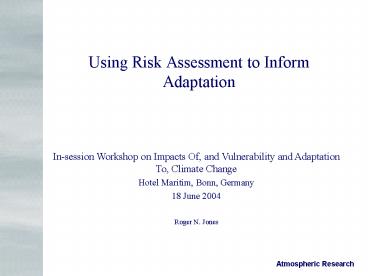Using Risk Assessment to Inform Adaptation - PowerPoint PPT Presentation
1 / 17
Title:
Using Risk Assessment to Inform Adaptation
Description:
Can be broadly defined as the likelihood of an adverse event or outcome ... www.undp.org/cc/apf.htm. UKCIP Willow and Connell (2003) www.ukcip.org.uk/risk_uncert ... – PowerPoint PPT presentation
Number of Views:12
Avg rating:3.0/5.0
Title: Using Risk Assessment to Inform Adaptation
1
Using Risk Assessment to Inform Adaptation
In-session Workshop on Impacts Of, and
Vulnerability and Adaptation To, Climate
Change Hotel Maritim, Bonn, Germany 18 June 2004
- Roger N. Jones
2
Risk
- Can be broadly defined as the likelihood of an
adverse event or outcome - How does this relate to Article 2 of the UNFCCC?
3
Article 2 UNFCCC
- Aims to prevent dangerous
- anthropogenic climate change
- by stabilising greenhouse gas emissions,
- thus allowing
- Ecosystems to adapt naturally
- Food security to be maintained
- Sustainable development to proceed
4
Scales of dangerous climate change
- Global thresholds of criticality
- Grounded ice sheet melts,
- N. Hemisphere flips to cold conditions,
- Amazon wilts and burns due to heat and drought
- Global in scale but very unlikely to occur (?
with ?T) - Local thresholds of criticality
- Any activity where
- the harm caused exceeds given levels of tolerance
- impacts become non-viable with no reasonable
substitute - Local in scale, number and severity increasing
with ?T, - benefits fewer with ?T
5
Linking climate to adaptation over time
6
Measuring the ability to cope
7
Coping under climate change
8
Adapting through the coping range
9
(No Transcript)
10
Different activities have different adaptive
capacities
Coral Reefs
Developed Country Agriculture
Developing Country Agriculture
Protected Coastal Infrastructure
11
Adaptation and mitigation
- Adaptation increases the coping range through
biological and social means - Mitigation reduces the magnitude and frequency of
greenhouse-related climate hazards - Therefore, they are complementary, not
interchangeable. - They also reduce different areas of climate
uncertainty
12
Some major methods
- Natural hazards method
- Risk Hazard Vulnerability
- (what are the likely damages?)
- Vulnerability-based method
- Risk Probability Consequence
- (what is the likelihood of exceeding a given
state of vulnerability?) - Policy assessment
- Does a given policy increase or decrease risk
under climate change?
13
Selecting a method
- Natural Hazard
- Probabilities of hazard constrained
- Main drivers known
- Chain of consequences understood
- P(Hazard) Consequences
- Exploratory
- Vulnerability
- Probabilities not constrained
- Many drivers
- Multiple pathways and feedbacks
- P(Vulnerability)
- e.g. critical threshold exceedance
- Normative
14
Likelihood of threshold exceedance
15
(No Transcript)
16
Activities most at risk
- Those where
- critical thresholds are exceeded at low levels of
global warming, - adaptive capacity is low and/or adaptation is
prohibitively expensive, difficult or unknown and
- the consequences of exceeding those thresholds
are judged to be serious
17
Resources
- UNDP Adaptation Policy Framework
- www.undp.org/cc/apf.htm
- UKCIP Willow and Connell (2003)
- www.ukcip.org.uk/risk_uncert































